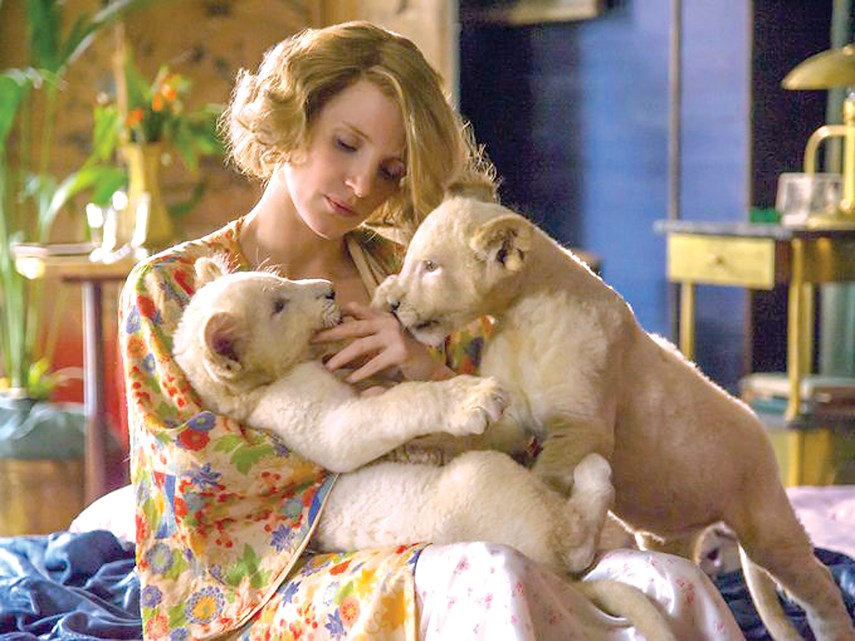The Zookeepers Wife. Directed by Niki Caro. Starring Jessica Chastain and Daniel Bruhl. Rating: 7 (out of 10)
Just when you thought movies about the Holocaust couldn’t get any more emotionally devastating, here comes the double whammy delivered by The Zookeeper’s Wife of human torment paired with the suffering of innocent animals.
It doesn’t sound like a promising night out, but this based-on-a-true-story is an all-out crowd-pleaser from start to finish, aided in large part by a touching performance by Jessica Chastain in the lead role of a woman who, along with her husband, turned their zoo into a safe haven for Jews fleeing the Warsaw ghetto
The film opens in 1939. Animals get equal emotional billing right off the mark, as Antonina Zabinski (Chastain) gives two cute and cuddly lion cubs a morning kiss while they sleep alongside her young son. She conducts daily rollcall of the animals with the help of a playful dromedary, and then flips off her shoes to help her husband Jan (Johan Heldenbergh) with the dirty work.
Put aside any political feelings you might have about private zoos, or zoos in general, and this is clearly one of the good ones, run by well-meaning caretakers who value compassion over personal profit.
A contingent from a German zoo visits and solidifies the Zabinskis’ place in the private-zoo food chain: a woman draped in furs (furs!) mocks her country-bumpkin clothing, but head of the Berlin Zoo Lutz Heck (Daniel Bruhl) has a hot spot for Frau Zabinski, and defends her against society’s wolves. They bond over the near-fatal birth of an elephant, as the visitors sip cocktails nearby.
But their Eden can’t last; the whole of the city is pummelled by German Luftwaffe. This may be the first time we’ve seen an animal response to large-scale bombing on film, and it’s devastating, as is the otherworldly scene of lions and jaguars roaming the rubble of Warsaw’s streets after the zoo enclosures are blown apart.
“We can save your animals together,” says Lutz, doing all but twirl his mustache. Appointed as Hitler’s head zoologist, Lutz promises to give “temporary” shelter to the Zabinskis’ more valuable animals in Germany. The theft of prized exotics was along the same line as poaching of prized artwork and jewels by the Nazi regime. The rest of the zoo would be liquidated for meat, firewood and soap.
Desperate to save the animals and their home, Antonina proposes turning the zoo into a pig farm to feed German troops. She also plays on Lutz’s vanity project, a proposal with Hitler’s right-hand man Hermann Goering to breed a long-extinct species of bison native to Germany. Lutz’s discussions about genetic experimentation is especially chilling given the party’s horrific history of eugenics and experiments on human subjects. He agrees.
In October 1940, Jews were herded into the Warsaw Ghetto, “a human zoo,” notes Antonina. Gentiles pose for snaps outside the ghetto gates, not unlike visitors to Antonina’s zoo posing with their prized animals. The pig farm is a clever cover for Jan to smuggle Jews out of the ghetto as he brings food scraps to feed the swine.
Chastain’s portrayal may be pitch perfect, but it is initially tone deaf: her Polish accent takes some getting used to, as do several others by non-German actors in the film. Despite a fine performance Flemish actor Heldenbergh seems miscast as Chastain’s husband, and competes with the head zookeeper (Game of Thrones’ Michael McElhatton) for our attention. The film is a shade overlong but entertaining, and satisfies our need for survivor stories, joining Schindler’s List in that regard.
War doesn’t only happen to men, as Caro’s film attests: women, children and animals are also casualties of war. The source material was written by a woman, Diane Akerman, and directed and produced by women. It’s no wonder, then, that the film forgoes battle scenes for the most part and focuses on the domestic details and personal perils of women during wartime. There is rape, there is the bartering of sexual favours for mercy, and there are dire relationship consequences between wives who must submit to dominant forces and husbands who are powerless to intervene.



